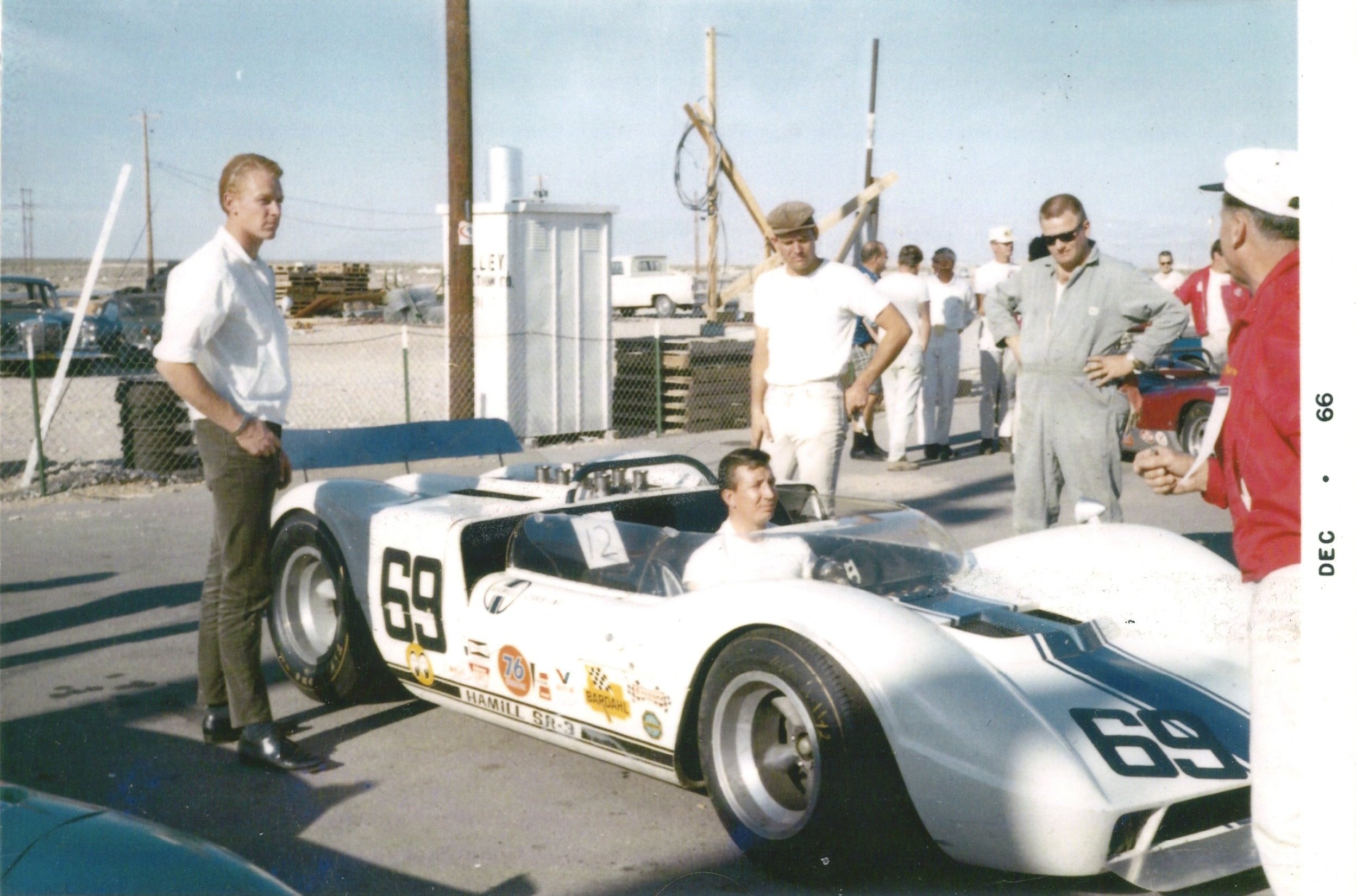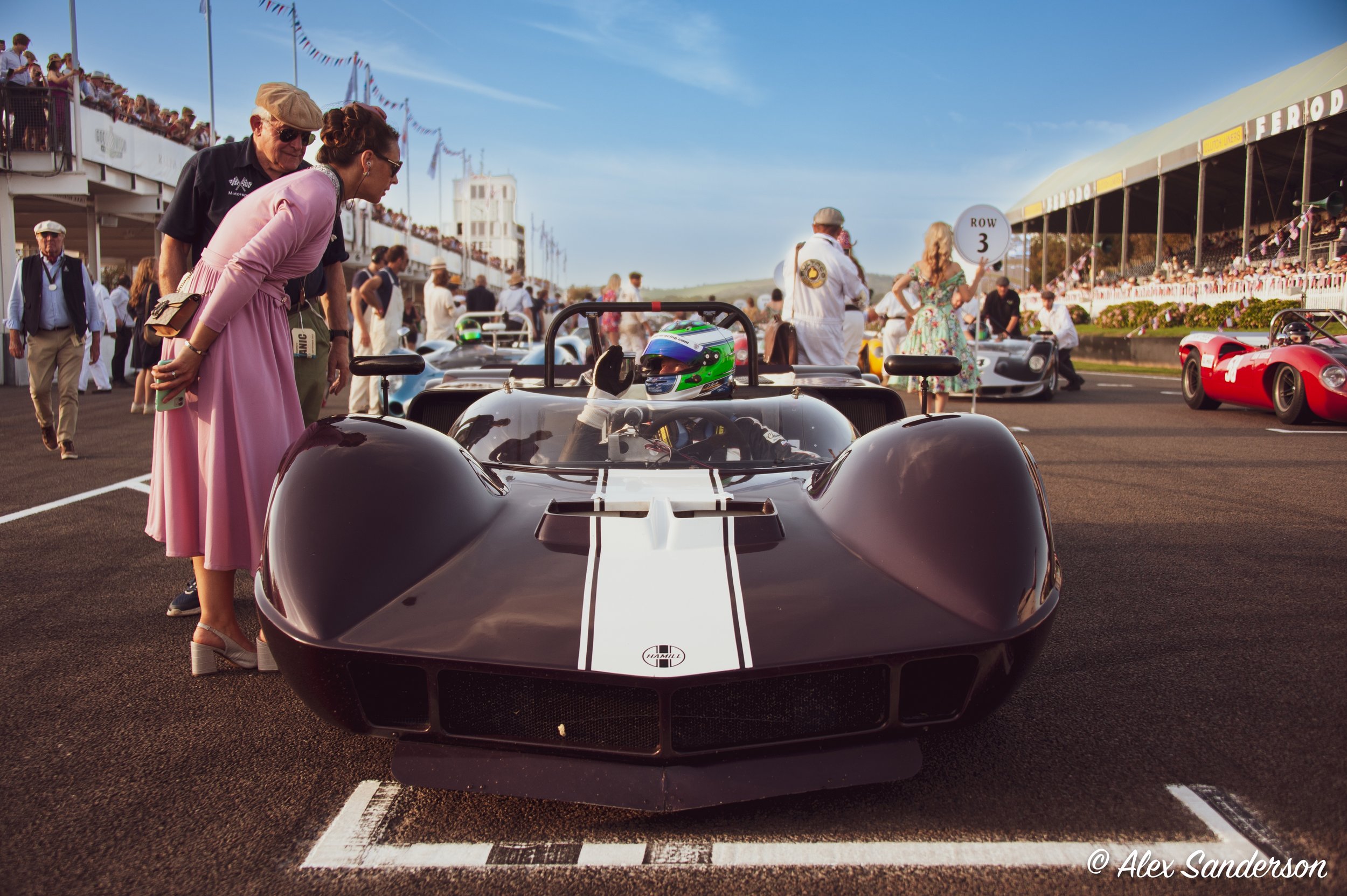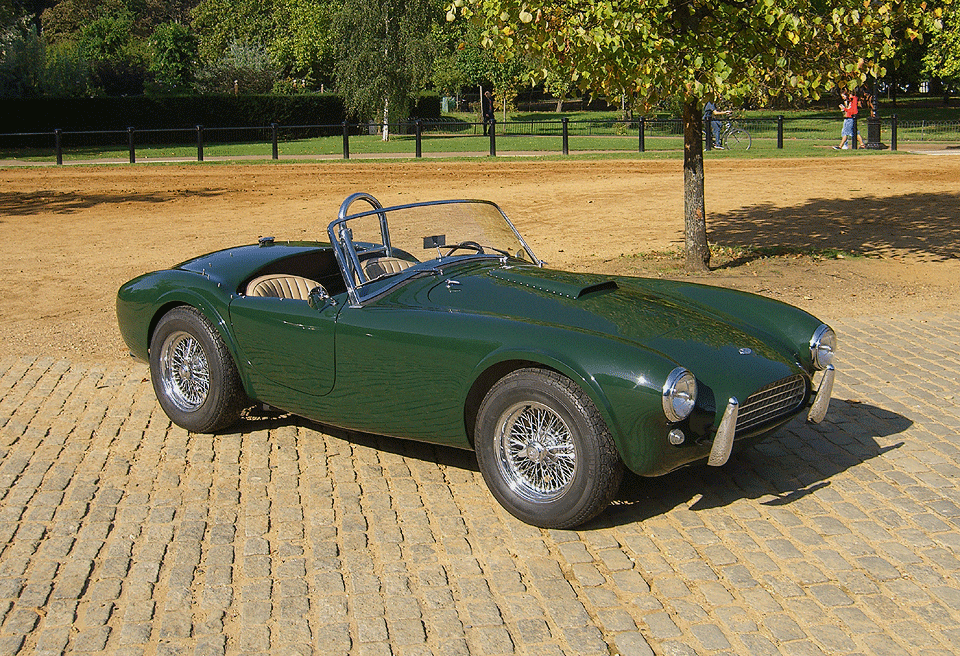
The Legacy of Ed Hamill and the Hamill SR-3 Racecar
Welcome, thank you for your interest in Ed Hamill and the history of the Hamill SR-3 Racecar.
This website is has been created by Ed’s family to celebrate the integral part he played in 1960s car racing history and to inspire future generations.
Ed is alive and well living in Colorado, though not online. However, if you’d like to reach out you can contact us and we will do our best to pass the message along to him.
Banner Image: Nick Padmore driving the Hamill SR-3 owned by Roland Lewis at the Super Charged Classics, Goodwood Revival, in September 2023. Photograph by Alex Sanderson.
Biography of Ed Hamill
Editors Note: To see the images better, is recommended to view this on a desktop rather than a mobile device.
1939-1960: Ed’s Early Life and Family History
Edward Brewington Hamill was born in 1939 in Belleville, Illinois, to Gertrude Hamill (née Brewington, 1904-1995) and Charles Pace Hamill (1882-1965). Ed had one brother, Charles Jr., who was 3 years his senior (1936-2018).
Ed’s paternal grandfather, James Millar Hamill, was a lawyer in the railroad industry. One of his clients was the legendary railroad magnate Jay Gould. At the time of his death in 1919, James had 10 railroad corporations in his practice.
Ed’s father, Charles, followed his father James into the law, and graduated from Harvard Law School. According to Ed:
“Dad confided to mom he probably would have preferred to study medicine, but his father was hopeful that he would join him in his law practice. Dad had an immense love and admiration for the law and its practice. He worked in concert with his father James and amassed all of their practice for the railroads after James passing.”
After his father James’ passing, Charles decided to reduce his concentration on the railroad legacy, as he wasn’t fond of railroad injury law, which had become central to running the railroad corporations due to all the workplace injuries that were happening at this time. He established and ran a bank, called the St. Clair National Bank in Belleville, and was quite successful with it (the bank was acquired by the First National Bank of Belleville in 1971). Later in life, Charles helped establish the Belleville Memorial Hospital, which is still thriving today.
Ed’s mother Gertrude was a nursing graduate of the University of Michigan. She was also an interior decorator, artist, and painted landscapes in particular. Her love of art and color helped shape Ed’s passion for design, form and color in his sports cars.
In his childhood, Ed spent his summers in Waterton Lakes National Park, in Alberta, Canada. His parents purchased a lot there in 1946, and designed and built a cabin with extensive collaboration with Doug Oland, one of the iconic Prince of Wales Hotel builders. Ed’s summers in Waterton helped establish his lifelong passion for the West and the outdoors.
From childhood Ed and his brother Charles were both keenly interested in hot rods and sports cars, especially their design and performance. They were great fans of those early days of post WWII amateur (on the cusp of professional) U.S. road racing, which made legends of drivers like Carroll Shelby (subject of the 2019 film Ford v. Ferrari), Phil Hill, Dan Gurney, and Richie Ginter. While Max Balchowsky, Lance Reventlow and Canadian Bill Sadler’s car building and driving skills showed that we could compete with the world’s best.
1952?- Giclée painting of the Prince of Wales Hotel with Waterton Lake in the background by Ed’s mom Gertrude Hamill. Photo credit: Unique Antiques
1958-1962: SCCA Car Racing and Working for Carroll Shelby
Ed’s first experience building a sports car was in high school, when he and his friends designed and fabricated a dragster from the ground up. Around that time Ed also purchased his first car, a used ‘55 Austin Healy, from Oliver C. Joseph and son Dee, who owned Oliver C. Joseph Chrysler Dodge Jeep Ram, one of the first sports car dealers in Southern Illinois. Oliver C. and Ed’s Dad were friends and business partners.
When Ed’s brother Charles turned 21—the minimum age to obtain an SCCA car racing license—Ed encouraged him to race his ‘57 Corvette in SCCA Southern Illinois Division. Ed was still 18, and for the next three years he did all the race prep and was pit crew for Charles. Those times helped soothe Ed’s racing dreams until at long last in the spring of 1961 he turned 21.
Ed purchased a Corvette from his brother Charles so he could start racing. The car was a 1960 Chevrolet Corvette B/P SCCA race car (you can read a wonderful story about the restoration of this car by Dave Dawdy here). Despite never having any driving lessons, Ed has no problem obtaining his racing license, and immediately entered the Alton Drag Way. To his surprise, he won two trophies: the Street Eliminator trophy in BSP (he posted a speed of 105.882 mph and 15.45 seconds elapsed time), and the class record of 108 mph with a time of 12.9 seconds.
1961- Ed at his second race ever, on the grid at the Lawrenceville, IL SCCA championship race. Ed’s Corvette #6 is far left. He’s on the pole with Midwest Division Champ Van Vandawalker #711 and Central Division Champ Mac Yates #7. Photo Credit: Dave Dawdy
1962- Ed racing in his 1960 Chevrolet Corvette at Indianapolis Raceway Park. Ed’s handwriting on a post-it in the corner.
This began his involvement in the SCCA racing events, and he completed two active seasons in summers of 1961 and 1962. He also got his novice and regular license in the Southern Illinois Region. He raced in Opelousas, LA, and across the Midwest where he would cross paths with drivers such as Jim Hall, Hap Sharp, Roy Kumnick, Dick Gulstrand, Grady Davis, Bob Johnson, Bob Spooner, and others.
In the fall of 1961, Ed enrolled in an engineering program at the Northrup Institute of Technology in Los Angeles, California, and drove his Corvette across the country. While in Los Angeles, he followed the local racing activities and spent time at Riverside Raceway. It was there Ed met Carroll Shelby, who hired Ed on the spot to work for him. In Ed’s words:
“I met Carroll Sheby at a Riverside, California race in 1962 where he was introducing the brand new prototype Shelby AC Cobra (CSX 2000). He hired me on the spot after seeing my enthusiasm for his project and telling him of my project of installing a Chevy Engine in my 1954 AC Ace. Carroll’s shop was at Dean Moon’s facilities. I met Dean after starting work with Carroll, in Santa Fe Springs.”
Ed was Carroll’s 2nd employee ever, working at the shop that was the American birthplace of the legendary Ford Cobra. It was a dream job for Ed — he was only in his first year of engineering, and he was already getting paid to help build race cars with one of his longtime heroes. At the time, there were only four people at the shop: Carroll; Carroll’s administrative assistant and then girlfriend, Joan Cole; a mechanic/fabricator, Mel Chastain; and Ed. During this time, Ed used his 1960 Corvette to participate in the Carroll Shelby Performance Car Driving School.
1962 - Carroll Shelby, assembling the first Shelby AC Cobra at Dean Moon’s speed shop Moon Eyes in Santa Fe Springs, CA. On this day, February 2nd, 1962, Carroll drove this car for the first time, marking the birth of the Shelby American. Ed met Carroll and began working at this shop shortly afterward. Photo credit: Shelby American Facebook Page
1962-1963: Training in the Air National Guard and Opening the First Cobra Dealership
Ed’s work for Carroll ended abruptly in June 1962, when he was ordered to return St. Louis area for a draft induction physical. While waiting to be called up to active duty, he was able to race the summer SCCA circuit with his Corvette. He also opened the first Cobra dealership, in St. Louis. Carroll sent him two of the first production cars of the AC Cobra from the production line, this included the Chassis No. CSX 2016 and CSX 2017.
In Ed’s words:
“Carroll and I spoke a number of times while I was working for him in California, He’d said his plan was to have 11 dealerships in major U.S. cities, which would serve also serve larger regions. He initially told me I could have a 300 mile radius of the St. Louis region. After the Cobra was a huge hit at the Spring 1962 New York International Auto Show public introduction, Ford had caught the Cobra fever too and wanted Ford dealers to be able to offer Cobras too. In his [Carroll’s] June 1962 letter to me, he changed his original offer to me. He wrote: ‘I’m not going to give you a “bunch” of territory, but neither am I going to appoint someone else in the immediate future in your area.’”
1962- One of the cars sold by Ed at his Cobra dealership. This 1962 Shelby Cobra, Chassix No. CSX 2016 was the 16th production car built, and was invoiced to Ed Hamill in November 1962. He kept this car as a demonstration model years before selling it in September 1965. Photo credit and car history: Bradfield Cars.
1962- This 1962 Competition Cobra CSX-2017 was also one of the first production cars, and invoiced to Ed in November 1962, who sold it in his dealership. Photo credit and car history: Victoria’s Special Auto Brokers
Ed entered military service in November 1962 (at that time all men between age 18-26 were eligible to be drafted through the Selective Service System), and was able to join the 131st Tactical Squadron of the Missouri Air National Guard (MO ANG). He was selected as a jet engine mechanic, and trained at the Amarillo Air Force Base (AFB) Jet Engine School in Texas.
1963: Amarillo Air Force Base Jet Engine School, graduating class of 1963. Ed’s note on the back of the photo says: “Bill Fuerch is Fourth and I’m fifth from the right in the back row. Gerry Netler (a roommate and fellow Missouri Air National Guard Member) is second from right in the bottom row.”
1963-1966: Building Race Cars and Racing Professionally
Ed graduated from the Amarillo AFB Jet Engine School in April 1963. Following that, he was required to stay in reserves and live near the Scott Air Force Base near his hometown of Belleville, IL. Upon returning, Ed turned his attention back to car racing, as well as engineering and building his own race cars. He built four cars between 1963-66: the Hamill R-1 Indy, the Hamill SR-2 Chevrolet, and two Hamill SR-3s.
1st - The Hamill R-1 Indy, completed 1964
This was the first car that Ed completed in order to make the 1964 Indy 500 at the Indianapolis Motor Speedway. It was originally called the MARC 1 Indy before Ed changed his company name from “Mid-American Racing Cars” (MARC) to “Hamill Cars.” It was entered as the “Delta International Movers Special” by well-known Indy entrant Al Dean (Dean Van Lines).
The Hamill R-1 Indy had a 4 cyclinder Offy engine and the low unsprung weight rear suspension design, with inboard disc brakes and magnesium uprights. The front suspension was also low unsprung weight and aerodynamically clean with inboard springs and shocks, and magnesium uprights. The control arms and the all were the same he used in the Hamill SR-2. The car was one of the first rear-engine cars at Indianapolis, and at 24-years-old, Ed was possibly one of the youngest designer/builders ever at Indy.



![1964 - Ed Hamill in the Hamill R-1 Indy on the Bear alignment rack in "Gasoline Alley", the garage area at the [Indiana Motorsport] Speedway.](https://images.squarespace-cdn.com/content/v1/656a23ab467c8c0e3afcc27f/1703198677710-EYBCXTVO8M8XUI5VIE3T/1964-ed-in-indy-bear-alignment.jpg)

2nd - The Hamill SR-2 Chevrolet, completed 1964
This was the first car that Ed started building, although it was finished after the Indy Car. Unfortunately, almost immediately upon completion, was sold to a friend, and promptly destroyed in a race accident. It has an Chevrolet Engine.
Ed shared with his niece Liz that the image below of bringing the SR-2 home to show his parents was one of his proudest and happiest moments of his life.
3rd and 4th - The Hamill SR-3s, completed in 1965 and 1966
In 1965, Ed started building the Hamill SR-3s. The original SR-3s could utilise any of the small block American V-8 engines (i.e. Ford, Chevrolet, Oldsmobile, Dodge and AMC).
Ed’s own SR-3 was completed in 1965, and was raced by Ed and others. Ed still owns this car and hopes it will race again someday at the Goodwood Revival. It presently doesn’t have an engine, and he wants to oversee the build of the engine himself. (You can donate to this project here.)
The second SR-3 was completed in 1966. It now lives in the UK and has been running at the Goodwood Revival since 2008. Roy Kumnick drove this car in Can-Am in 1966. Over the course of its life it has run in countless regular and vintage races with a number of different owners and drivers. The restored car has been raced by Darren Turner (3-time LeMans winner) at the 2018 Goodwood Revival, among others. (More photos and videos in next section.)



Ed’s Professional Racing Career
Ed and the Hamill SR-3 raced 17 professional races in 1965 and 1966, with Ed driving 16 of them including a 3rd place at the 1965 Nassau Bahamas Speed Week Governor’s Trophy Race. At the time Canada paid start money, but the US races did not. You can see his racing stats here.
At the end of the 1966 racing season, Ed had a new car design in mind, and had a prospective 1967 season sponsored by Firestone Tires. He had also been offered sponsorship by Goodyear Tires. However, Firestone withdrew all motorsport sponsorship at the last minute, despite Ed’s outstanding support by the Firestone Race Crew. He went back to Goodyear, but the opportunity was gone. Sadly, this ended Ed’s racing career.
1965- Ed kneeling next to his Hamill SR-3 at Nassau, where he placed 3rd.
1966- Ed with his racing helmet on. His sponsor Firestone’s logo is visible on his left breast. This at one of his last car races.
1966- Ed at the pre-race driver’s parade, sitting on the right side of the photo, again with his Firestone race outfit on. Earl Jones is on Ed’s right. Independent Professional Race, Mont Tremblant-St. Jovite, Quebec, Canada. July 1966. (Side note: Bruce McLaren, founder of the McLaren racing team, won the race.)
1967- Present: Life After Car Racing
After racing, Ed went back to university, then joined the Peace Corps and worked in South America for two and a half years. Upon returning he applied to veterinary school, but the prerequisites had changed and he’d have to study another year of undergraduate courses. He didn’t want to do that, so he dabbled in real estate, and eventually bought a ranch in Colorado, where he still lives to this day. He has 320-400 head of cattle, and has lived a relatively solitary life.
He enjoys cross-country skiing, and he still loves working in his shop on cars, as well as carpentry and various projects for the land. He’s involved in land preservation and forestry. Ed is a lifelong Methodist and has a strong faith in God.
2018- Ed standing next to Hamill SR-3, which he still owns and keeps in the United States.
2017- Ed his shop, still tinkering with engines.
This biography was written by Jess McNally, with editing and feedback from Ed Hamill, in February 2024.
Gratitude to Reverend Keith Morrison, the Honorary Chaplain at Goodwood Road Racing Company, who interviewed Ed on May 26, 2023, and provided notes, as well to Dave Dowdy for this article; these provided invaluable information for this biography. Additional notes and feedback were provided by Ed’s niece Liz Hamill Howard, who initiated and spearheaded the creation of this website. Liz is a peer-reviewed healthcare chaplain, trained within the Stanford and UCSF Medical communities.
The Hamill SR-3 at Goodwood
One of the Hamill SR-3s was restored and has been racing at Goodwood Revival since 2008.
Some news articles can be found below:




Contact Us
We welcome feedback and comments on this site. While Ed is not online, any messages received we will do our best to share with him.
Please allow us 3-5 days to respond.
Website Design by Marten Street Media. All content subject to copyright.

















